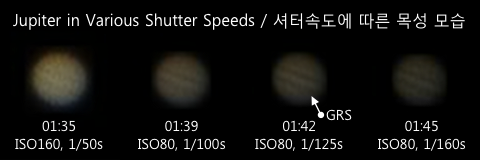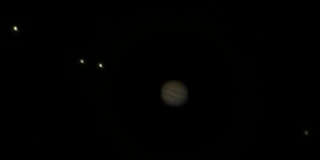Getting optimal Jupiter shots w/ SX50 HS
Posted by Wesley on
Jupiter photos at various shutter speeds (200% size)
Like it was back in June for Saturn,it would be a good time to get photos of Jupiter for the next couple of months. Earth is getting closer to it, meaning bigger angular diameter (about 41.9" now, and will peak at 46.8" in early January), and it rises high up in the sky during the night, lowering distortion from atmospheric disturbance.
With nature cooperating, I tried various combinations of ISO and shutter speed settings on my Canon SX50 HS to capture distinct cloud bands of Jupiter. Today's sweet spot seemed to be at 1/125s with ISO 80 setting. Too bright or dark, and the bands became hard to tell apart. At the optimal setting, the thickening of the lower band was noticeable, and that's where the Great Red Spot (GRS) was.
And this is a composition of that optimal Jupiter photo over the Galilean satellites I took a few minutes later. The satellites are Ganymede, Europa, Io, and Callisto from left to right. Jovian system was at about 44.8 degrees above horizon and climbing the eastern sky, so it was vertically arranged. The photo was rotated clockwise by 90 degrees to show the system horizontally. Read further for specific settings I used.
